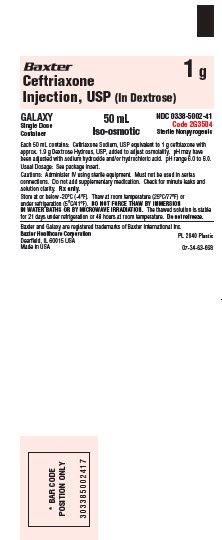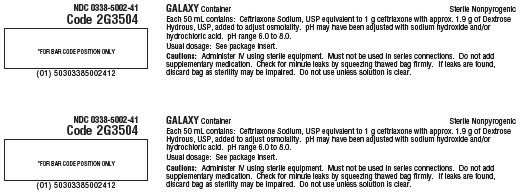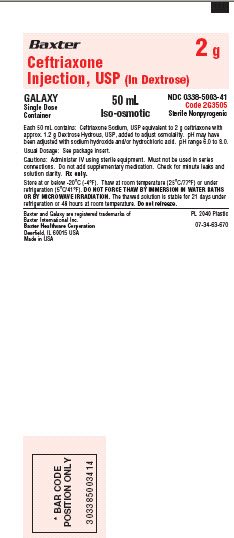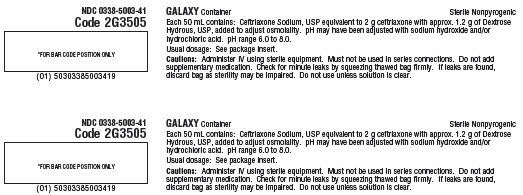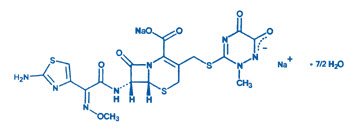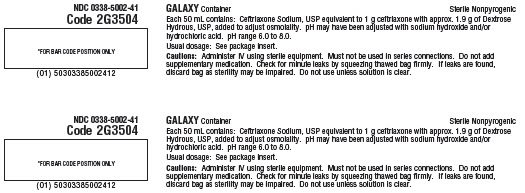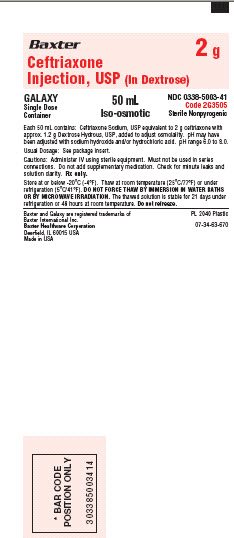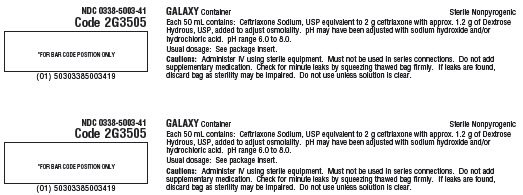Label: CEFTRIAXONE- ceftriaxone sodium injection, solution
- NDC Code(s): 0338-5002-41, 0338-5003-41
- Packager: Baxter Healthcare Corporation
- Category: HUMAN PRESCRIPTION DRUG LABEL
- DEA Schedule: None
- Marketing Status: Abbreviated New Drug Application
Drug Label Information
Updated March 22, 2024
If you are a consumer or patient please visit this version.
- Download DRUG LABEL INFO: PDF XML
- Official Label (Printer Friendly)
- SPL UNCLASSIFIED SECTION
-
DESCRIPTION
Ceftriaxone Injection, USP is a sterile, semisynthetic, broad-spectrum cephalosporin antibiotic for intravenous administration. Ceftriaxone sodium is (6R,7R)-7-[2-(2-Amino-4-thiazolyl)glyoxylamido]-8-oxo-3-[[(1,2,5,6-tetrahydro-2-methyl-5,6-dioxo-as-triazin-3-yl)thio]methyl]-5-thia-1-azabicyclo[4.2.0]oct-2-ene-2-carboxylic acid, 7²-(Z)-(O-methyloxime), disodium salt, sesquaterhydrate.
The chemical formula of ceftriaxone sodium is C18H16N8Na2O7S3•7/2 H2O. It has a calculated molecular weight of 661.60 and the following structural formula:
Ceftriaxone Sodium, USP is a white to yellowish-orange crystalline powder which is readily soluble in water, sparingly soluble in methanol and very slightly soluble in ethanol.
Ceftriaxone Injection, USP contains approximately 83 mg (3.6 mEq) of sodium per gram of ceftriaxone activity.
Ceftriaxone Injection, USP is supplied as a frozen, iso-osmotic, sterile, nonpyrogenic solution premixed in a dextrose diluent. Dextrose, USP has been added to adjust the osmolality (approximately 1.9 g and 1.2 g as dextrose hydrous to the 1 g and 2 g dosages, respectively). The pH may be adjusted with sodium hydroxide and/or hydrochloric acid. Solutions of premixed Ceftriaxone Injection, USP may range from light yellow to amber in color. After thawing, the solution is intended for intravenous use. The pH of thawed solutions may range from 6.0 to 8.0. See HOW SUPPLIED for package description.
The plastic container for the frozen solution is fabricated from a specially designed multilayer plastic. Solutions are in contact with the polyethylene layer of this container and can leach out certain chemical components of the plastic in very small amounts within the expiration period. The suitability of the plastic has been confirmed in tests in animals according to the USP biological tests for plastic containers as well as by tissue culture toxicity studies.
-
CLINICAL PHARMACOLOGY
Average plasma concentrations of ceftriaxone following a single 30-minute intravenous (IV) infusion of a 0.5, 1 or 2 gm dose in healthy subjects are presented in Table 1.
Table 1 - *
- IV doses were infused at a constant rate over 30 minutes.
Ceftriaxone Plasma Concentrations
After Single Dose AdministrationDose/Route
Average Plasma Concentrations (mcg/mL)
0.5 hr
1 hr
2 hr
4 hr
6 hr
8 hr
12 hr
16 hr
24 hr
0.5 gm IV*
82
59
48
37
29
23
15
10
5
1 gm IV*
151
111
88
67
53
43
28
18
9
2 gm IV*
257
192
154
117
89
74
46
31
15
Multiple IV doses ranging from 0.5 to 2 gm at 12- to 24-hour intervals resulted in 15% to 36% accumulation of ceftriaxone above single dose values.
Ceftriaxone concentrations in urine are shown in Table 2.
Table 2 Urinary Concentrations of Ceftriaxone
After Single Dose AdministrationDose/Route
Average Urinary Concentrations (mcg/mL)
0-2 hr
2-4 hr
4-8 hr
8-12 hr
12-24 hr
24-48 hr
0.5 gm IV
526
366
142
87
70
15
1 gm IV
995
855
293
147
132
32
2 gm IV
2692
1976
757
274
198
40
Thirty-three percent to 67% of a ceftriaxone dose was excreted in the urine as unchanged drug and the remainder was secreted in the bile and ultimately found in the feces as microbiologically inactive compounds. After a 1 gm IV dose, average concentrations of ceftriaxone, determined from 1 to 3 hours after dosing, were 581 mcg/mL in the gallbladder bile, 788 mcg/mL in the common duct bile, 898 mcg/mL in the cystic duct bile, 78.2 mcg/gm in the gallbladder wall and 62.1 mcg/mL in the concurrent plasma.
Over a 0.15 to 3 gm dose range in healthy adult subjects, the values of elimination half-life ranged from 5.8 to 8.7 hours; apparent volume of distribution from 5.78 to 13.5 L; plasma clearance from 0.58 to 1.45 L/hour; and renal clearance from 0.32 to 0.73 L/hour. Ceftriaxone is reversibly bound to human plasma proteins, and the binding decreased from a value of 95% bound at plasma concentrations of <25 mcg/mL to a value of 85% bound at 300 mcg/mL. Ceftriaxone crosses the blood placenta barrier.
The average values of maximum plasma concentration, elimination half-life, plasma clearance and volume of distribution after a 50 mg/kg IV dose and after a 75 mg/kg IV dose in pediatric patients suffering from bacterial meningitis are shown in Table 3. Ceftriaxone penetrated the inflamed meninges of infants and pediatric patients; CSF concentrations after a 50 mg/kg IV dose and after a 75 mg/kg IV dose are also shown in Table 3.
Table 3 Average Pharmacokinetic Parameters
of Ceftriaxone in Pediatric Patients
With Meningitis50 mg/kg IV
75 mg/kg IV
Maximum Plasma Concentrations (mcg/mL)
216
275
Elimination Half-life (hr)
4.6
4.3
Plasma Clearance (mL/hr/kg)
49
60
Volume of Distribution (mL/kg)
338
373
CSF Concentration - inflamed meninges (mcg/mL)
5.6
6.4
Range (mcg/mL)
1.3-18.5
1.3-44
Time after dose (hr)
3.7 (± 1.6)
3.3 (± 1.4)
Compared to that in healthy adult subjects, the pharmacokinetics of ceftriaxone were only minimally altered in elderly subjects and in patients with renal impairment or hepatic dysfunction (Table 4); therefore, dosage adjustments are not necessary for these patients with ceftriaxone dosages up to 2 gm per day. Ceftriaxone was not removed to any significant extent from the plasma by hemodialysis. In 6 of 26 dialysis patients, the elimination rate of ceftriaxone was markedly reduced.
Table 4 - *
- Creatinine clearance.
Average Pharmacokinetic Parameters
of Ceftriaxone in HumansSubject
GroupElimination
Half-life
(hr)Plasma
Clearance
(L/hr)Volume of
Distribution
(L)Healthy Subjects
5.8-8.7
0.58-1.45
5.8-13.5
Elderly Subjects (mean age, 70.5 yr)
8.9
0.83
10.7
Patients With Renal Impairment
Hemodialysis Patients (0-5 mL/min)*
14.7
0.65
13.7
Severe (5-15 mL/min)
15.7
0.56
12.5
Moderate (16-30 mL/min)
11.4
0.72
11.8
Mild (31-60 mL/min)
12.4
0.70
13.3
Patients With Liver Disease
8.8
1.1
13.6
The elimination of ceftriaxone is not altered when Ceftriaxone Injection is co-administered with probenecid.
Interaction with Calcium
Two in vitro studies, one using adult plasma and the other neonatal plasma from umbilical cord blood, have been carried out to assess interaction of ceftriaxone and calcium. Ceftriaxone concentrations up to 1 mM (in excess of concentrations achieved in vivo following administration of 2 grams ceftriaxone infused over 30 minutes) were used in combination with calcium concentrations up to 12 mM (48 mg/dL). Recovery of ceftriaxone from plasma was reduced with calcium concentrations of 6 mM (24 mg/dL) or higher in adult plasma or 4 mM (16 mg/dL) or higher in neonatal plasma. This may be reflective of ceftriaxone-calcium precipitation.
Microbiology
The bactericidal activity of ceftriaxone results from inhibition of cell wall synthesis. Ceftriaxone has a high degree of stability in the presence of beta-lactamases, both penicillinases and cephalosporinases, of gram-negative and gram-positive bacteria.
In an in vitro study antagonistic effects have been observed with the combination of chloramphenicol and ceftriaxone.
Ceftriaxone has been shown to be active against most strains of the following microorganisms, both in vitro and in clinical infections described in the INDICATIONS AND USAGE section.
Aerobic gram-negative microorganisms:
Acinetobacter calcoaceticus
Enterobacter aerogenes
Enterobacter cloacae
Escherichia coli
Haemophilus influenzae (including ampicillin-resistant and beta-lactamase producing strains)
Haemophilus parainfluenzae
Klebsiella oxytoca
Klebsiella pneumoniae
Moraxella catarrhalis (including beta-lactamase producing strains)
Morganella morganii
Neisseria gonorrhoeae (including penicillinase- and nonpenicillinase-producing strains)
Neisseria meningitidis
Proteus mirabilis
Proteus vulgaris
Serratia marcescens
Ceftriaxone is also active against many strains of Pseudomonas aeruginosa.
NOTE: Many strains of the above organisms that are resistant to multiple antibiotics, e.g., penicillins, cephalosporins, and aminoglycosides, are susceptible to ceftriaxone.
Aerobic gram-positive microorganisms:
Staphylococcus aureus (including penicillinase-producing strains)
Staphylococcus epidermidis
Streptococcus pneumoniae
Streptococcus pyogenes
Viridans group streptococci
NOTE: Methicillin-resistant staphylococci are resistant to cephalosporins, including ceftriaxone. Most strains of Group D streptococci and enterococci, e.g., Enterococcus (Streptococcus) faecalis, are resistant.
Anaerobic microorganisms:
Bacteroides fragilis
Clostridium species
Peptostreptococcus species
NOTE: Most strains of Clostridioides difficile are resistant.
The following in vitro data are available, but their clinical significance is unknown. Ceftriaxone exhibits in vitro minimal inhibitory concentrations (MICs) of ≤1 mcg/mL or less against most strains of the following microorganisms, however, the safety and effectiveness of ceftriaxone in treating clinical infections due to these microorganisms have not been established in adequate and well-controlled clinical trials.
Aerobic gram-negative microorganisms:
Citrobacter diversus
Citrobacter freundii
Providencia species (including Providencia rettgeri)
Salmonella species (including Salmonella typhi)
Shigella species
Aerobic gram-positive microorganisms:
Streptococcus agalactiae
Anaerobic microorganisms:
Prevotella (Bacteroides) bivius
Porphyromonas (Bacteroides) melaninogenicus
Susceptibility Tests
For specific information regarding susceptibility test interpretive criteria and associated test methods and quality control standards recognized by FDA for this drug, please see: http://www.fda.gov/STIC.
-
INDICATIONS AND USAGE
Before instituting treatment with Ceftriaxone Injection, appropriate specimens should be obtained for isolation of the causative organism and for determination of its susceptibility to the drug. Therapy may be instituted prior to obtaining results of susceptibility testing.
To reduce the development of drug-resistant bacteria and maintain the effectiveness of Ceftriaxone Injection and other antibacterial drugs, Ceftriaxone Injection should be used only to treat or prevent infections that are proven or strongly suspected to be caused by susceptible bacteria. When culture and susceptibility information are available, they should be considered in selecting or modifying antibacterial therapy. In the absence of such data, local epidemiology and susceptibility patterns may contribute to the empiric selection of therapy.
Ceftriaxone Injection is indicated for the treatment of the following infections when caused by susceptible organisms:
LOWER RESPIRATORY TRACT INFECTIONS caused by Streptococcus pneumoniae, Staphylococcus aureus, Haemophilus influenzae, Haemophilus parainfluenzae, Klebsiella pneumoniae, Escherichia coli, Enterobacter aerogenes, Proteus mirabilis or Serratia marcescens.
ACUTE BACTERIAL OTITIS MEDIA caused by Streptococcus pneumoniae, Haemophilus influenzae (including beta-lactamase producing strains) or Moraxella catarrhalis (including beta-lactamase producing strains).
NOTE: In one study lower clinical cure rates were observed with a single dose of ceftriaxone compared to 10 days of oral therapy. In a second study comparable cure rates were observed between single dose ceftriaxone and the comparator. The potentially lower clinical cure rate of ceftriaxone should be balanced against the potential advantages of parenteral therapy.
SKIN AND SKIN STRUCTURE INFECTIONS caused by Staphylococcus aureus, Staphylococcus epidermidis, Streptococcus pyogenes, Viridans group streptococci, Escherichia coli, Enterobacter cloacae, Klebsiella oxytoca, Klebsiella pneumoniae, Proteus mirabilis, Morganella morganii,* Pseudomonas aeruginosa, Serratia marcescens, Acinetobacter calcoaceticus, Bacteroides fragilis* or Peptostreptococcus species.
URINARY TRACT INFECTIONS (complicated and uncomplicated) caused by Escherichia coli, Proteus mirabilis, Proteus vulgaris, Morganella morganii or Klebsiella pneumoniae.
UNCOMPLICATED GONORRHEA (cervical/urethral and rectal) caused by Neisseria gonorrhoeae, including both penicillinase-and nonpenicillinase-producing strains, and pharyngeal gonorrhea caused by nonpenicillinase-producing strains of Neisseria gonorrhoeae.
PELVIC INFLAMMATORY DISEASE caused by Neisseria gonorrhoeae. Ceftriaxone, like other cephalosporins, has no activity against Chlamydia trachomatis. Therefore, when cephalosporins are used in the treatment of patients with pelvic inflammatory disease and Chlamydia trachomatis is one of the suspected pathogens, appropriate antichlamydial coverage should be added.
BACTERIAL SEPTICEMIA caused by Staphylococcus aureus, Streptococcus pneumoniae, Escherichia coli, Haemophilus influenzae or Klebsiella pneumoniae.
BONE AND JOINT INFECTIONS caused by Staphylococcus aureus, Streptococcus pneumoniae, Escherichia coli, Proteus mirabilis, Klebsiella pneumoniae or Enterobacter species.
INTRA-ABDOMINAL INFECTIONS caused by Escherichia coli, Klebsiella pneumoniae, Bacteroides fragilis, Clostridium species (Note: most strains of Clostridioides difficile are resistant) or Peptostreptococcus species.
MENINGITIS caused by Haemophilus influenzae, Neisseria meningitidis or Streptococcus pneumoniae. Ceftriaxone has also been used successfully in a limited number of cases of meningitis and shunt infection caused by Staphylococcus epidermidis* and Escherichia coli.*
*Efficacy for this organism in this organ system was studied in fewer than ten infections.
SURGICAL PROPHYLAXIS: The preoperative administration of a single 1 gm dose of ceftriaxone may reduce the incidence of postoperative infections in patients undergoing surgical procedures classified as contaminated or potentially contaminated (e.g., vaginal or abdominal hysterectomy or cholecystectomy for chronic calculous cholecystitis in high-risk patients, such as those over 70 years of age, with acute cholecystitis not requiring therapeutic antimicrobials, obstructive jaundice or common duct bile stones) and in surgical patients for whom infection at the operative site would present serious risk (e.g., during coronary artery bypass surgery). Although ceftriaxone has been shown to have been as effective as cefazolin in the prevention of infection following coronary artery bypass surgery, no placebo-controlled trials have been conducted to evaluate any cephalosporin antibiotic in the prevention of infection following coronary artery bypass surgery.
When administered prior to surgical procedures for which it is indicated, a single 1 gm dose of ceftriaxone provides protection from most infections due to susceptible organisms throughout the course of the procedure.
-
CONTRAINDICATIONS
Ceftriaxone Injection is contraindicated in patients with known allergy to the cephalosporin class of antibiotics. Solutions containing dextrose may be contraindicated in patients with known allergy to corn or corn products.
Neonates (≤28 days)
Hyperbilirubinemic neonates, especially prematures, should not be treated with Ceftriaxone Injection. In vitro studies have shown that ceftriaxone can displace bilirubin from its binding to serum albumin, leading to a possible risk of bilirubin encephalopathy in these patients.
Ceftriaxone Injection is contraindicated in neonates if they require (or are expected to require) treatment with calcium-containing IV solutions, including continuous calcium-containing infusions such as parenteral nutrition because of the risk of precipitation of ceftriaxone-calcium (see CLINICAL PHARMACOLOGY, WARNINGS and DOSAGE AND ADMINISTRATION).
A small number of cases of fatal outcomes in which a crystalline material was observed in the lungs and kidneys at autopsy have been reported in neonates receiving ceftriaxone and calcium-containing fluids. In some of these cases, the same intravenous infusion line was used for both ceftriaxone and calcium-containing fluids and in some a precipitate was observed in the intravenous infusion line. At least one fatality has been reported in a neonate in whom ceftriaxone and calcium-containing fluids were administered at different time points via different intravenous lines; no crystalline material was observed at autopsy in this neonate. There have been no similar reports in patients other than neonates.
-
WARNINGS
Hypersensitivity
BEFORE THERAPY WITH CEFTRIAXONE INJECTION IS INSTITUTED, CAREFUL INQUIRY SHOULD BE MADE TO DETERMINE WHETHER THE PATIENT HAS HAD PREVIOUS HYPERSENSITIVITY REACTIONS TO CEPHALOSPORINS, PENICILLINS OR OTHER DRUGS. THIS PRODUCT SHOULD BE GIVEN CAUTIOUSLY TO PENICILLIN-SENSITIVE PATIENTS. ANTIBIOTICS SHOULD BE ADMINISTERED WITH CAUTION TO ANY PATIENT WHO HAS DEMONSTRATED SOME FORM OF ALLERGY, PARTICULARLY TO DRUGS. SERIOUS ACUTE HYPERSENSITIVITY REACTIONS MAY REQUIRE THE USE OF SUBCUTANEOUS EPINEPHRINE AND OTHER EMERGENCY MEASURES.
As with other cephalosporins, anaphylactic reactions with fatal outcome have been reported, even if a patient is not known to be allergic or previously exposed.
Interaction with Calcium-Containing Products
Do not further dilute ceftriaxone injection with products containing calcium, such as Ringer’s solution or Hartmann’s solution, because a precipitate can form. Precipitation of ceftriaxone-calcium can also occur when ceftriaxone is mixed with calcium-containing solutions in the same IV administration line. Ceftriaxone must not be administered simultaneously with calcium-containing IV solutions, including continuous calcium-containing infusions such as parenteral nutrition via a Y-site. However, in patients other than neonates, ceftriaxone and calcium-containing solutions may be administered sequentially of one another if the infusion lines are thoroughly flushed between infusions with a compatible fluid. In vitro studies using adult and neonatal plasma from umbilical cord blood demonstrated that neonates have an increased risk of precipitation of ceftriaxone-calcium (see CLINICAL PHARMACOLOGY, CONTRAINDICATIONS and DOSAGE AND ADMINISTRATION).
Neurological Adverse Reactions
Serious neurological adverse reactions have been reported during postmarketing surveillance with ceftriaxone use. These reactions include encephalopathy (disturbance of consciousness including somnolence, lethargy, and confusion), seizures, myoclonus, and non-convulsive status epilepticus (see ADVERSE REACTIONS). Some cases occurred in patients with severe renal impairment who did not receive appropriate dosage adjustment. However, in other cases, neurological adverse reactions occurred in patients receiving an appropriate dosage adjustment. The neurological adverse reactions were reversible and resolved after discontinuation. If neurological adverse reactions associated with Ceftriaxone Injection therapy occur, discontinue Ceftriaxone Injection and institute appropriate supportive measures. Make appropriate dosage adjustments in patients with severe renal impairment (see DOSAGE AND ADMINISTRATION).
Clostridioides difficile
Clostridioides difficile associated diarrhea (CDAD) has been reported with use of nearly all antibacterial agents, including Ceftriaxone Injection and may range in severity from mild diarrhea to fatal colitis. Treatment with antibacterial agents alters the normal flora of the colon leading to overgrowth of C. difficile.
C. difficile produces toxins A and B which contribute to the development of CDAD. Hypertoxin producing strains of C. difficile cause increased morbidity and mortality, as these infections can be refractory to antimicrobial therapy and may require colectomy. CDAD must be considered in all patients who present with diarrhea following antibiotic use. Careful medical history is necessary since CDAD has been reported to occur over two months after the administration of antibacterial agents.
If CDAD is suspected or confirmed, ongoing antibiotic use not directed against C. difficile may need to be discontinued. Appropriate fluid and electrolyte management, protein supplementation, antibiotic treatment of C. difficile, and surgical evaluation should be instituted as clinically indicated.
Hemolytic Anemia
An immune mediated hemolytic anemia has been observed in patients receiving cephalosporin class antibacterials including ceftriaxone. Severe cases of hemolytic anemia, including fatalities, have been reported during treatment in both adults and children. If a patient develops anemia while on ceftriaxone, the diagnosis of a cephalosporin associated anemia should be considered and ceftriaxone stopped until the etiology is determined.
-
PRECAUTIONS
General
Prescribing Ceftriaxone Injection in the absence of a proven or strongly suspected bacterial infection or a prophylactic indication is unlikely to provide benefit to the patient and increases the risk of the development of drug-resistant bacteria.
Although transient elevations of BUN and serum creatinine have been observed, at the recommended dosages, the nephrotoxic potential of Ceftriaxone Injection is similar to that of other cephalosporins.
Ceftriaxone is excreted via both biliary and renal excretion (see CLINICAL PHARMACOLOGY). Therefore, patients with mild to moderate renal impairment normally require no adjustment in dosage when usual doses of Ceftriaxone Injection are administered.
Dosage adjustments should not be necessary in patients with hepatic dysfunction; however, in patients with both hepatic dysfunction and significant renal disease, caution should be exercised and the Ceftriaxone Injection dosage should not exceed 2 gm daily.
Ceftriaxone has been associated with a fall in prothrombin activity. Those at risk include patients with renal or hepatic impairment or poor nutritional state, as well as patients receiving a protracted course of antimicrobial therapy, and patients previously stabilized on anticoagulant therapy. Prothrombin time should be monitored in patients at risk and exogenous vitamin K administered as indicated.
Prolonged use of Ceftriaxone Injection may result in overgrowth of nonsusceptible organisms. Careful observation of the patient is essential. If superinfection occurs during therapy, appropriate measures should be taken.
Ceftriaxone Injection should be prescribed with caution in individuals with a history of gastrointestinal disease, especially colitis.
There have been reports of sonographic abnormalities in the gallbladder of patients treated with ceftriaxone; some of these patients also had symptoms of gallbladder disease. These abnormalities appear on sonography as an echo without acoustical shadowing suggesting sludge or as an echo with acoustical shadowing which may be misinterpreted as gallstones. The chemical nature of the sonographically detected material has been determined to be predominantly a ceftriaxone-calcium salt. The condition appears to be transient and reversible upon discontinuation of ceftriaxone and institution of conservative management. Therefore, Ceftriaxone Injection should be discontinued in patients who develop signs and symptoms suggestive of gallbladder disease and/or the sonographic findings described above.
Cases of pancreatitis, possibly secondary to biliary obstruction, have been reported rarely in patients treated with ceftriaxone. Most patients presented with risk factors for biliary stasis and biliary sludge (preceding major therapy, severe illness, total parenteral nutrition). A cofactor role of ceftriaxone related biliary precipitation cannot be ruled out.
Information for Patients
Advise patients that neurological adverse reactions could occur with Ceftriaxone Injection use. Instruct patients or their caregivers to inform their healthcare provider at once of any neurological signs and symptoms, including encephalopathy (disturbance of consciousness including somnolence, lethargy, and confusion), seizures, myoclonus, and nonconvulsive status epilepticus, for immediate treatment, or discontinuation of Ceftriaxone Injection (see WARNINGS AND PRECAUTIONS).
Patients should be counseled that antibacterial drugs including Ceftriaxone Injection should only be used to treat bacterial infections. They do not treat viral infections (e.g., the common cold). When Ceftriaxone Injection is prescribed to treat a bacterial infection, patients should be told that although it is common to feel better early in the course of therapy, the medication should be taken exactly as directed. Skipping doses or not completing the full course of therapy may (1) decrease the effectiveness of the immediate treatment and (2) increase the likelihood that bacteria will develop resistance and will not be treatable by Ceftriaxone Injection or other antibacterial drugs in the future.
Diarrhea is a common problem caused by antibiotics which usually ends when the antibiotic is discontinued. Sometimes after starting treatment with antibiotics, patients can develop watery and bloody stools (with or without stomach cramps and fever) even as late as two or more months after having taken the last dose of the antibiotic. If this occurs, patients should contact their physician as soon as possible.
Carcinogenesis, Mutagenesis, Impairment of Fertility
Carcinogenesis
Considering the maximum duration of treatment and the class of the compound, carcinogenicity studies with ceftriaxone in animals have not been performed. The maximum duration of animal toxicity studies was 6 months.
Pregnancy
Teratogenic Effects
Reproductive studies have been performed in mice and rats at doses up to 20 times the usual human dose and have no evidence of embryotoxicity, fetotoxicity or teratogenicity. In primates, no embryotoxicity or teratogenicity was demonstrated at a dose approximately 3 times the human dose.
There are, however, no adequate and well-controlled studies in pregnant women. Because animal reproductive studies are not always predictive of human response, this drug should be used during pregnancy only if clearly needed.
Nonteratogenic Effects
In rats, in the Segment I (fertility and general reproduction) and Segment III (perinatal and postnatal) studies with intravenously administered ceftriaxone, no adverse effects were noted on various reproductive parameters during gestation and lactation, including postnatal growth, functional behavior and reproductive ability of the offspring, at doses of 586 mg/kg/day or less.
Nursing Mothers
Low concentrations of ceftriaxone are excreted in human milk. Caution should be exercised when Ceftriaxone Injection is administered to a nursing woman.
Pediatric Use
Safety and effectiveness of Ceftriaxone Injection in neonates, infants and pediatric patients have been established for the dosages described in the DOSAGE AND ADMINISTRATION section. In vitro studies have shown that ceftriaxone, like some other cephalosporins, can displace bilirubin from serum albumin. Ceftriaxone Injection should not be administered to hyperbilirubinemic neonates, especially prematures (see CONTRAINDICATIONS).
Geriatric Use
Of the total number of subjects in clinical studies of ceftriaxone, 32% were 60 and over. No overall differences in safety or effectiveness were observed between these subjects and younger subjects, and other reported clinical experience has not identified differences in responses between the elderly and younger patients, but greater sensitivity of some older individuals cannot be ruled out.
The pharmacokinetics of ceftriaxone were only minimally altered in geriatric patients compared to healthy adult subjects and dosage adjustments are not necessary for geriatric patients with ceftriaxone dosages up to 2 grams per day (see CLINICAL PHARMACOLOGY).
-
ADVERSE REACTIONS
Ceftriaxone is generally well tolerated. In clinical trials, the following adverse reactions, which were considered to be related to ceftriaxone therapy or of uncertain etiology, were observed:
LOCAL REACTIONS — pain, induration and tenderness was 1% overall. Phlebitis was reported in <1% after IV administration.
HYPERSENSITIVITY — rash (1.7%). Less frequently reported (<1%) were pruritus, fever or chills.
HEMATOLOGIC — eosinophilia (6%), thrombocytosis (5.1%) and leukopenia (2.1%). Less frequently reported (<1%) were anemia, hemolytic anemia, neutropenia, lymphopenia, thrombocytopenia and prolongation of the prothrombin time.
GASTROINTESTINAL — diarrhea (2.7%). Less frequently reported (<1%) were nausea or vomiting, and dysgeusia. The onset of pseudomembranous colitis symptoms may occur during or after antibacterial treatment (see WARNINGS).
HEPATIC — elevations of SGOT (3.1%) or SGPT (3.3%). Less frequently reported (<1%) were elevations of alkaline phosphatase and bilirubin.
RENAL — elevations of the BUN (1.2%). Less frequently reported (<1%) were elevations of creatinine and the presence of casts in the urine.
CENTRAL NERVOUS SYSTEM — headache or dizziness were reported occasionally (<1%).
GENITOURINARY — moniliasis or vaginitis were reported occasionally (<1%).
MISCELLANEOUS — diaphoresis and flushing were reported occasionally (<1%).
Other rarely observed adverse reactions (<0.1%) include abdominal pain, agranulocytosis, allergic pneumonitis, anaphylaxis, basophilia, biliary lithiasis, bronchospasm, colitis, dyspepsia, epistaxis, flatulence, gallbladder sludge, glycosuria, hematuria, jaundice, leukocytosis, lymphocytosis, monocytosis, nephrolithiasis, palpitations, a decrease in the prothrombin time, renal precipitations, seizures, and serum sickness.
Postmarketing Experience
In addition to the adverse reactions reported during clinical trials, the following adverse experiences have been reported during clinical practice in patients treated with ceftriaxone. Data are generally insufficient to allow an estimate of incidence or to establish causation.
A small number of cases of fatal outcomes in which a crystalline material was observed in the lungs and kidneys at autopsy have been reported in neonates receiving ceftriaxone and calcium-containing fluids. In some of these cases, the same intravenous infusion line was used for both ceftriaxone and calcium-containing fluids and in some a precipitate was observed in the intravenous infusion line. At least one fatality has been reported in a neonate in whom ceftriaxone and calcium-containing fluids were administered at different time points via different intravenous lines; no crystalline material was observed at autopsy in this neonate. There have been no similar reports in patients other than neonates.
GASTROINTESTINAL – stomatitis and glossitis.
GENITOURINARY – oliguria.
DERMATOLOGIC – exanthema, allergic dermatitis, urticaria, edema. As with many medications, isolated cases of severe cutaneous adverse reactions (erythema multiforme, Stevens-Johnson syndrome or Lyell’s syndrome/toxic epidermal necrolysis) have been reported.
NEUROLOGIC – Encephalopathy, seizures, myoclonus, and non-convulsive status epilepticus (see WARNINGS AND PRECAUTIONS).
Cephalosporin Class Adverse Reactions
In addition to the adverse reactions listed above which have been observed in patients treated with ceftriaxone, the following adverse reactions and altered laboratory test results have been reported for cephalosporin class antibiotics:
Adverse Reactions
Allergic reactions, drug fever, serum sickness-like reaction, renal dysfunction, toxic nephropathy, reversible hyperactivity, hypertonia, hepatic dysfunction including cholestasis, aplastic anemia, hemorrhage, fall in prothrombin activity, and superinfection.
Altered Laboratory Tests
Positive direct Coombs’ test, false-positive test for urinary glucose, and elevated LDH.
Several cephalosporins have been implicated in triggering seizures, particularly in patients with renal impairment when the dosage was not reduced (see DOSAGE AND ADMINISTRATION). If seizures associated with drug therapy occur, the drug should be discontinued. Anticonvulsant therapy can be given if clinically indicated.
-
OVERDOSAGE
Ceftriaxone overdosage has been reported in patients with severe renal impairment. Reactions have included neurological outcomes, including encephalopathy, seizures, myoclonus, and non-convulsive status epilepticus. In the event of overdosage, discontinue Ceftriaxone Injection therapy and provide general supportive treatment (see DOSAGE AND ADMINISTRATION and WARNINGS AND PRECAUTIONS).
In the case of overdosage, drug concentration would not be reduced by hemodialysis or peritoneal dialysis. There is no specific antidote. Treatment of overdosage should be symptomatic.
-
DOSAGE AND ADMINISTRATION
Ceftriaxone Injection is administered intravenously.
Do not further dilute ceftriaxone injection with products containing calcium, such as Ringer’s solution or Hartmann’s solution, because a precipitate can form. Precipitation of ceftriaxone-calcium can also occur when ceftriaxone is mixed with calcium-containing solutions in the same IV administration line. Ceftriaxone must not be administered simultaneously with calcium-containing IV solutions, including continuous calcium-containing infusions such as parenteral nutrition via a Y-site. However, in patients other than neonates, ceftriaxone and calcium-containing solutions may be administered sequentially of one another if the infusion lines are thoroughly flushed between infusions with a compatible fluid (see WARNINGS).
There have been no reports of an interaction between ceftriaxone and oral calcium-containing products.
Neonates
Hyperbilirubinemic neonates, especially prematures, should not be treated with Ceftriaxone Injection (see CONTRAINDICATIONS).
Ceftriaxone is contraindicated in neonates if they require (or are expected to require) treatment with calcium-containing IV solutions, including continuous calcium-containing infusions such as parenteral nutrition because of the risk of precipitation of ceftriaxone-calcium (see CONTRAINDICATIONS).
Pediatric Patients
For the treatment of skin and skin structure infections, the recommended total daily dose is 50 to 75 mg/kg given once a day (or in equally divided doses twice a day). The total daily dose should not exceed 2 grams.
For the treatment of serious miscellaneous infections other than meningitis, the recommended total daily dose is 50 to 75 mg/kg, given in divided doses every 12 hours. The total daily dose should not exceed 2 grams.
In the treatment of meningitis, it is recommended that the initial therapeutic dose be 100 mg/kg (not to exceed 4 grams). Thereafter, a total daily dose of 100 mg/kg/day (not to exceed 4 grams daily) is recommended. The daily dose may be administered once a day (or in equally divided doses every 12 hours). The usual duration of therapy is 7 to 14 days.
Adults
The usual adult daily dose is 1 to 2 grams given once a day (or in equally divided doses twice a day) depending on the type and severity of infection. For infections caused by Staphylococcus aureus (MSSA), the recommended daily dose is 2 to 4 grams, in order to achieve >90% target attainment. The total daily dose should not exceed 4 grams.
If Chlamydia trachomatis is a suspected pathogen, appropriate antichlamydial coverage should be added, because ceftriaxone sodium has no activity against this organism.
For preoperative use (surgical prophylaxis), a single dose of 1 gram administered intravenously 1/2 to 2 hours before surgery is recommended.
Generally, Ceftriaxone Injection therapy should be continued for at least 2 days after the signs and symptoms of infection have disappeared. The usual duration of therapy is 4 to 14 days; in complicated infections, longer therapy may be required.
When treating infections caused by Streptococcus pyogenes, therapy should be continued for at least 10 days.
No dosage adjustment is necessary for patients with impairment of hepatic impairment or mild to moderate renal impairment.
-
DIRECTIONS FOR USE
Ceftriaxone Injection is for intravenous administration using sterile equipment. It should be administered intravenously by infusion over a period of 30 minutes.
Do not add supplementary medication. Vancomycin, amsacrine, aminoglycosides, and fluconazole are physically incompatible with ceftriaxone in admixtures. When any of these drugs are to be administered concomitantly with ceftriaxone by intermittent intravenous infusion, it is recommended that they be given sequentially, with thorough flushing of the intravenous lines (with one of the compatible fluids) between the administrations.
Thawing of Plastic Container
Thaw frozen container at room temperature (25°C/77°F) or under refrigeration (5°C/41°F). [DO NOT FORCE THAW BY IMMERSION IN WATER BATHS OR BY MICROWAVE IRRADIATION.]
Check for minute leaks by squeezing container firmly. If leaks are detected, discard solution as sterility may be impaired.
Do not add supplementary medication.
Visually inspect the container. If the outlet port protector is damaged, detached, or not present, discard container as solution path sterility may be impaired. Components of the solution may precipitate in the frozen state and will dissolve upon reaching room temperature with little or no agitation. Potency is not affected. Agitate after solution has reached room temperature. If after visual inspection the solution remains cloudy or if an insoluble precipitate is noted, or if any seals are not intact, the container should be discarded.
The thawed solution is stable for 21 days under refrigeration (5°C/41°F) or 48 hours at room temperature (25°C/77°F). Do not refreeze thawed antibiotics.
Caution: Do not use plastic containers in series connections. Such use could result in air embolism due to residual air being drawn from the primary container before administration of the fluid from the secondary container is complete.
-
ANIMAL PHARMACOLOGY
Concretions consisting of the precipitated calcium salt of ceftriaxone have been found in the gallbladder bile of dogs and baboons treated with ceftriaxone.
These appeared as a gritty sediment in dogs that received 100 mg/kg/day for 4 weeks. A similar phenomenon has been observed in baboons but only after a protracted dosing period (6 months) at higher dose levels (335 mg/kg/day or more). The likelihood of this occurrence in humans is considered to be low, since ceftriaxone has a greater plasma half-life in humans, the calcium salt of ceftriaxone is more soluble in human gallbladder bile and the calcium content of human gallbladder bile is relatively low.
-
HOW SUPPLIED/STORAGE AND HANDLING
Ceftriaxone Injection, USP is supplied premixed as a frozen, iso-osmotic, sterile, nonpyrogenic solution of ceftriaxone sodium in a case of 24 x 50 mL single dose Galaxy containers. The following strengths are available:
1 gm equivalent of ceftriaxone, iso-osmotic with approximately 1.9 gm Dextrose Hydrous, USP, added (NDC 0338-5002-41).
2 gm equivalent of ceftriaxone, iso-osmotic with approximately 1.2 gm Dextrose Hydrous, USP, added (NDC 0338-5003-41).
NOTE: Store Ceftriaxone Injection, USP in the frozen state at or below -20°C/-4°F. See DIRECTIONS FOR USE:
Handle frozen product containers with care. Product containers may be fragile in the frozen state.
- SPL UNCLASSIFIED SECTION
-
PACKAGE LABEL - PRINCIPAL DISPLAY PANEL
Container Label 1 g
Baxter
Ceftriaxone
Injection, USP (In Dextrose)1 g
GALAXY
Single Dose
Container50 mL
Iso-osmoticNDC 0338-5002-41
Code 2G3505
Sterile NonpyrogenicEach 50 mL contains: Ceftriaxone Sodium, USP equivalent to 1 g ceftriaxone with
approx. 1.9 g Dextrose Hydrous, USP, added to adjust osmolality. pH may have
been adjusted with sodium hydroxide and/or hydrochloric acid. pH range 6.0 to 8.0.Usual Dosage: See package insert.
Cautions: Administer IV using sterile equipment. Must not be used in series
connections. Do not add supplementary medication. Check for minute leaks and
solution clarity. Rx only.Store at or below -20°C (-4°F). Thaw at room temperature (25°C/77°F) or
under refrigeration (5°C/41°F). DO NOT FORCE THAW BY IMMERSION
IN WATER BATHS OR BY MICROWAVE IRRADIATION. The thawed solution is stable for 21 days under refrigeration or 48 hours at room temperature. Do not refreeze.Baxter and GALAXY are trademarks of Baxter International Inc.
Baxter Healthcare Corporation
Deerfield, IL 60015 USA
Made in USAPL 2040 Plastic
07-34-63-668
*BAR CODE POSITION ONLY
303385002417Carton Label - 1 g - Panel 1
Thaw at room temperature (25°C/77°F) or under refrigeration (5°C/41°F). DO NOT FORCE
THAW BY IMMERSION IN WATER BATHS OR BY MICROWAVE IRRADIATION. The thawed solution is stable for 21 days under refrigeration or 48 hours at room temperature.
Do not refreeze.Handle frozen product containers with care. Product containers may be fragile in the frozen state.
Baxter and Galaxy are registered trademarks of Baxter International Inc.
PL 2040 Plastic07-04-65-179
Baxter Logo
Ceftriaxone Injection, USP (In Dextrose)
12 - 50 mL Single-Dose Containers Iso-osmotic
Store at or below -20°C/-4°F. Do not refreeze.Rx only
1 g
Baxter Healthcare Corporation
Deerfield, IL 60015 USAThaw at room temperature (25°C/77°F) or under refrigeration (5°C/41°F). DO NOT FORCE
THAW BYIMMERSION IN WATER BATHS OR BY MICROWAVE IRRADIATION.
The thawed solution is stable for 21 days under refrigeration or 48 hours at room temperature.
Do not refreeze.Handle frozen product containers with care. Product containers may be fragile in the frozen state.
Baxter and Galaxy are registered trademarks of Baxter International Inc.
PL 2040 Plastic07-04-65-179
Baxter Logo
Ceftriaxone Injection, USP (In Dextrose)
12 - 50 mL Single-Dose Containers Iso-osmotic
Store at or below -20°C/-4°F. Do not refreeze.Rx only
1 g
Baxter Healthcare Corporation
Deerfield, IL 60015 USACarton Label - 1 g - Panel 2
NDC 0338-5002-41
Code 2G3504
*FOR BAR CODE POSITION ONLY
(01) 503385002412GALAXY Container
Sterile Nonpyrogenic
Each 50 mL contains: Ceftriaxone Sodium, USP equivalent to 1 g ceftriaxone with approx.
1.9 g of Dextrose Hydrous, USP, added to adjust osmolality. pH may have been adjusted with
sodium hydroxide and/or hydrochloric acid. pH range 6.0 to 8.0.Usual dosage: See package insert.
Cautions: Administer IV using sterile equipment. Must not be used in series connections.
Do not add supplementary medication. Check for minute leaks by squeezing thawed bag firmly. If leaks are found, discard bag as sterility may be impaired. Do not use unless solution is clear.NDC 0338-5002-41
Code 2G3504
*FOR BAR CODE POSITION ONLY
(01) 503385002412GALAXY Container
Sterile Nonpyrogenic
Each 50 mL contains: Ceftriaxone Sodium, USP equivalent to 1 g ceftriaxone with approx.
1.9 g of Dextrose Hydrous, USP, added to adjust osmolality. pH may have been adjusted with
sodium hydroxide and/or hydrochloric acid. pH range 6.0 to 8.0.Usual dosage: See package insert.
Cautions: Administer IV using sterile equipment. Must not be used in series connections.
Do not add supplementary medication. Check for minute leaks by squeezing thawed bag firmly. If leaks are found, discard bag as sterility may be impaired. Do not use unless solution is clear.Baxter Logo
Ceftriaxone
Injection, USP (In Dextrose)
2 gGALAXY
Single Dose
Container50 mL
Iso-osmoticNDC 0338-5003-41
Code 2G3505
Sterile NonpyrogenicEach 50 mL contains: Ceftriaxone Sodium, USP equivalent to 2 g ceftriaxone with
approx. 1.2 g of Dextrose Hydrous, USP, added to adjust osmolality. pH may have
been adjusted with sodium hydroxide and/or hydrochloric acid. pH range 6.0 to 8.0.Usual dosage: See package insert.
Cautions: Administer IV using sterile equipment. Must not be used in series
connections. Do not add supplementary medication. Check for minute leaks and
solution clarity. Rx only.Store at or below -20°C (-4°F). Thaw at room temperature (25°C/77°F) or under
refrigeration (5°C/41°F). DO NOT FORCE THAW BY IMMERSION IN WATER
BATHS OR BY MICROWAVE IRRADIATION. The thawed solution is stable for 21 days
under refrigeration or 48 hours at room temperature. Do not refreeze.Baxter and GALAXY are trademarks of
Baxter International Inc.
Baxter Healthcare Corporation
Deerfield, IL 60015 USA
Made in USAPL 2040 Plastic
07-34-63-670
*BAR CODE POSITION ONLY
303385003414Carton Label - 2 g - Panel 1
Thaw at room temperature (25°C/77°F) or under refrigeration (5°C/41°F). DO NOT FORCE
THAW BYIMMERSION IN WATER BATHS OR BY MICROWAVE IRRADIATION.
The thawed solution is stable for 21 days under refrigeration or 48 hours at room temperature.
Do not refreeze.
Handle frozen product containers with care. Product containers may be fragile in the frozen state.
Baxter and Galaxy are registered trademarks of Baxter International Inc.
PL 2040 Plastic07-04-65-180
Baxter Logo
Ceftriaxone Injection, USP (In Dextrose)
12 - 50 mL Single-Dose Containers Iso-osmotic
Store at or below -20°C/-4°F. Do not refreeze.Rx only
2 g
Baxter Healthcare Corporation
Deerfield, IL 60015 USAThaw at room temperature (25°C/77°F) or under refrigeration (5°C/41°F). DO NOT FORCE
THAW BYIMMERSION IN WATER BATHS OR BY MICROWAVE IRRADIATION.
The thawed solution is stable for 21 days under refrigeration or 48 hours at room temperature.
Do not refreeze.
Handle frozen product containers with care. Product containers may be fragile in the frozen state.
Baxter and Galaxy are registered trademarks of Baxter International Inc.
PL 2040 Plastic07-04-65-180
Baxter Logo
Ceftriaxone Injection, USP (In Dextrose)
12 - 50 mL Single-Dose Containers Iso-osmotic
Store at or below -20°C/-4°F. Do not refreeze.Rx only
2 g
Baxter Healthcare Corporation
Deerfield, IL 60015 USACarton Label - 2 g - Panel 2
NDC 0338-5003-41
Code 2G3505
*FOR BAR CODE POSITION ONLY
(01) 503385003419GALAXY Container
Sterile Nonpyrogenic
Each 50 mL contains: Ceftriaxone Sodium, USP equivalent to 2 g ceftriaxone with approx.
1.2 g of Dextrose Hydrous, USP, added to adjust osmolality. pH may have been adjusted with
sodium hydroxide and/or hydrochloric acid. pH range 6.0 to 8.0.Usual dosage: See package insert.
Cautions: Administer IV using sterile equipment. Must not be used in series connections.
Do not add supplementary medication. Check for minute leaks by squeezing thawed bag firmly. If leaks are found, discard bag as sterility may be impaired. Do not use unless solution is clear.NDC 0338-5003-41
Code 2G3505
*FOR BAR CODE POSITION ONLY
(01) 503385003419GALAXY Container
Sterile Nonpyrogenic
Each 50 mL contains: Ceftriaxone Sodium, USP equivalent to 2 g ceftriaxone with approx.
1.2 g of Dextrose Hydrous, USP, added to adjust osmolality. pH may have been adjusted with
sodium hydroxide and/or hydrochloric acid. pH range 6.0 to 8.0.Usual dosage: See package insert.
Cautions: Administer IV using sterile equipment. Must not be used in series connections.
Do not add supplementary medication. Check for minute leaks by squeezing thawed bag firmly. If leaks are found, discard bag as sterility may be impaired. Do not use unless solution is clear. -
INGREDIENTS AND APPEARANCE
CEFTRIAXONE
ceftriaxone sodium injection, solutionProduct Information Product Type HUMAN PRESCRIPTION DRUG Item Code (Source) NDC:0338-5002 Route of Administration INTRAVENOUS Active Ingredient/Active Moiety Ingredient Name Basis of Strength Strength CEFTRIAXONE SODIUM (UNII: 023Z5BR09K) (CEFTRIAXONE - UNII:75J73V1629) CEFTRIAXONE 1 g in 50 mL Inactive Ingredients Ingredient Name Strength DEXTROSE MONOHYDRATE (UNII: LX22YL083G) 1.9 g in 50 mL SODIUM HYDROXIDE (UNII: 55X04QC32I) HYDROCHLORIC ACID (UNII: QTT17582CB) WATER (UNII: 059QF0KO0R) Packaging # Item Code Package Description Marketing Start Date Marketing End Date 1 NDC:0338-5002-41 24 in 1 CASE 08/23/2005 1 50 mL in 1 BAG; Type 0: Not a Combination Product Marketing Information Marketing Category Application Number or Monograph Citation Marketing Start Date Marketing End Date ANDA ANDA065224 08/23/2005 CEFTRIAXONE
ceftriaxone sodium injection, solutionProduct Information Product Type HUMAN PRESCRIPTION DRUG Item Code (Source) NDC:0338-5003 Route of Administration INTRAVENOUS Active Ingredient/Active Moiety Ingredient Name Basis of Strength Strength CEFTRIAXONE SODIUM (UNII: 023Z5BR09K) (CEFTRIAXONE - UNII:75J73V1629) CEFTRIAXONE 2 g in 50 mL Inactive Ingredients Ingredient Name Strength DEXTROSE MONOHYDRATE (UNII: LX22YL083G) 1.2 g in 50 mL SODIUM HYDROXIDE (UNII: 55X04QC32I) HYDROCHLORIC ACID (UNII: QTT17582CB) WATER (UNII: 059QF0KO0R) Packaging # Item Code Package Description Marketing Start Date Marketing End Date 1 NDC:0338-5003-41 24 in 1 CASE 08/23/2005 1 50 mL in 1 BAG; Type 0: Not a Combination Product Marketing Information Marketing Category Application Number or Monograph Citation Marketing Start Date Marketing End Date ANDA ANDA065224 08/23/2005 Labeler - Baxter Healthcare Corporation (005083209) Establishment Name Address ID/FEI Business Operations Baxter Healthcare Corporation 194684502 MANUFACTURE(0338-5002, 0338-5003) , ANALYSIS(0338-5002, 0338-5003) , LABEL(0338-5002, 0338-5003) , PACK(0338-5002, 0338-5003) , STERILIZE(0338-5002, 0338-5003)

